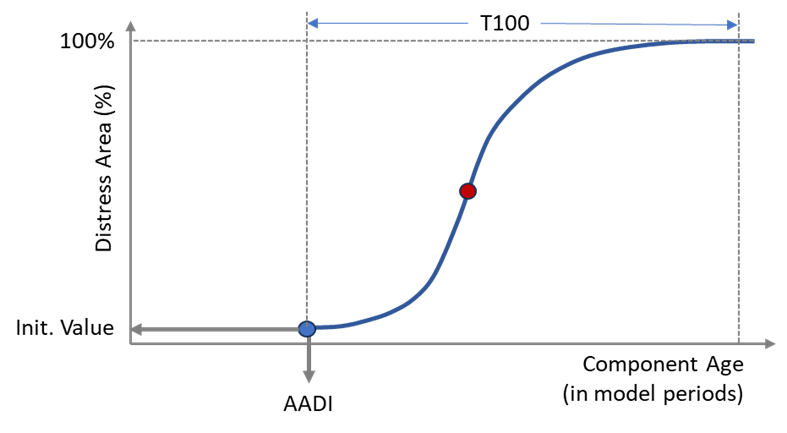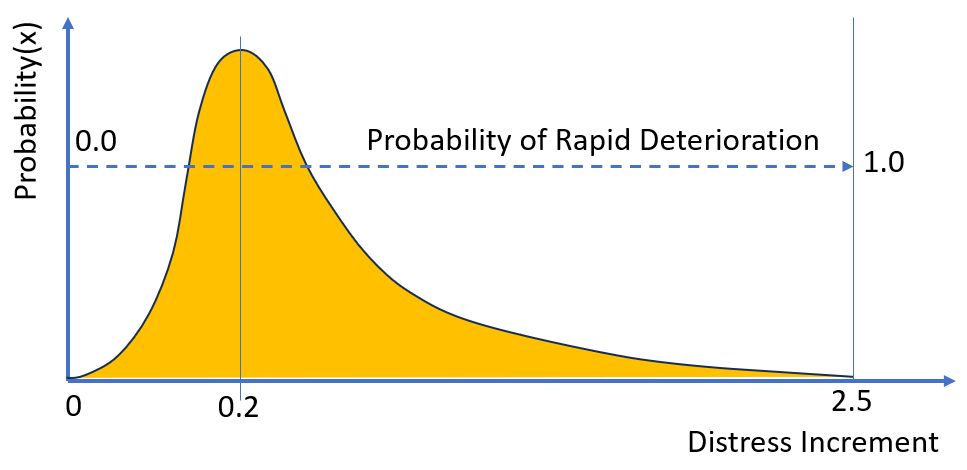Parameters Overview
Overview
The Default Juno Cassandra Road Deterioration model currently contains more than 50 parameters which are forecast over the modelling period. These parameters can be classified as:
- Visual Distresses
- Rutting and Roughness
- Surfacing and Pavement Information
- Condition Indexes
- Other Parameters such as intermediary information related to incrementing and debugging.
Details of the parameters that fall into each of the above groups are provided in the following sections.
This page only provides a conceptual overview of Model Parameters and their underlying logic. There are several technical “support” parameters that are calculated to provide intermediary information in the model calculations. These parameters are not discussed in detail here but are listed in the table of model parameters
Traffic
Traffic parameters included in the model are:
- Average Daily Traffic (ADT) and
- Percentage Heavy Vehicles
Visual Distresses
The following distresses are modelled:
- Flushing
- Scabbing
- Longitudinal & Transverse Cracks (“L&T Cracks”)
- Mesh Cracks (“Alligator” or “Crocodile Cracks”)
- Shoving
- Potholes
For the modelling of these distresses, an S-shaped model (similar to those used in the HDM3 models) is assumed, as shown below:
 In the paragraphs below, we provide a summary of the most salient features of the Default Juno Cassandra Road Deterioration model for Visual Distresses. For a more detailed discussion on how distresses are initialised, incremented and reset after treatment, please refer to the additional information section.
In the paragraphs below, we provide a summary of the most salient features of the Default Juno Cassandra Road Deterioration model for Visual Distresses. For a more detailed discussion on how distresses are initialised, incremented and reset after treatment, please refer to the additional information section.
This model is characterized by three parameters:
AADI = Age at Distress Initiation.
IV = Initial Value, i.e. percentage distress in the first year when distress initialises.
T100 = Number of years to theoretically reach 100% distress.
Of the above three parameters, AADI is the most important for short to medium term models. Details on how these three parameters are estimated for each of the Visual Distresses can be found at this page.
In Juno Cassandra, the S-Shape Progression JFunction is used to express these distress parameters. Details on how this model is expressed in Juno Cassandra can be found at this link.
The S-curve model for each distress is automatically calibrated at the start of the model run to take into account the existing (observed) distress, if any, on each segment. The observed condition is used to adjust the expected values for AADI, IV and T100 so that the predictions for each segment are inherently calibrated to the observed conditions for that segment. More details about the S-Curve calibration process can be found at this link.
Rutting and Roughness
For the progression of rutting and roughness, a distribution with a known shape is presumed for the increments. Typically, the distribution is heavily right-skewed as shown below.

The distribution shape, as well as the central tendency and maximum values for the distribution need to be provided as configuration parameters. In the above figure, the assumed distribution is right-skewed with a central tendency of 0.2 and a maximum value of 2.5.
These three values thus define the shape of the increment distribution for rutting and roughness. What remains now is to estimate the increment for each model segment. This is done by means of a logistic regression model which predicts the probability of observing excessive rut or roughness on each segment.
If the probability is high (close to 1.0), the increment assumed is towards the top of the assumed distribution. Conversely, if the increment is low (close to zero), the increment assigned to the segment will be towards the left side (below the central tendency).
The logistic regression models used to predict the probability of excessive rutting or roughness was developed using a large data set covering a range of Local Authorities. Generally, the probability is predicted as a function of:
- Traffic (ADT and Percentage Heavy)
- Surface and Pavement Age
- Other distress present
The last item noted above indicates that the rutting and roughness models are sensitive to the percentage of visual distresses on each segment. The roughness model, in turn, is also sensitive to the rut value.
A detailed discussion of the structure of the Logistic Regression equations used in the above explanation is beyond the scope of this documentation but detailed equations can be found in the model definition file.
Surfacing and Pavement
Parameters used to track information related to the Surfacing are the following:
- Surfacing Age (years)
- Surfacing Expected Life (years)
- Percent of Expected Surface Life Achieved
- Remaining Surface Life (years)
- Surface Material Type (e.g. ‘SMA’, ‘RACK’, ‘2CHIP’, ‘OGPA’)
- Surface Material Class (‘seal’, ‘ac’, ‘block-pave’ or ‘concrete’)
- Surface Function (‘1’ = First Coat; ‘2’ = Second Coat’ or ‘R’ = Reseal)
- Surface Total Thickness
- Number of Surfacing Layers
Parameters used to track information related to the Pavement structure are the following:
- Pavement Age
- Pavement Structural Remaining Life (based on MSD data if available, otherwise defaults or user defined values could be used).
Condition Indices
To summarise surfacing and pavement condition and facilitate the calculation of Benefit-Cost Analysis information, the following indices are defined:
Pavement Distress Index (PDI)
This index is scored from zero to 100 and represents the sum of the percentage of structural distresses. Some distresses, such as L&T cracks, are lightly weighted to limit their impact on the PDI. Distresses used in the PDI sum are:
- L&T Cracks (reduced to limit the influence)
- Mesh Cracks
- Shoving
- Potholes (weighted heavier to increase low percentage associated with potholes)
- Pavement-related Maintenance and Faults percentage (used only in short term)
Surfacing Distress Index (SDI)
This index is scored from zero to 100 and represents the sum of the percentage of surfacing distresses (i.e. non-structural). Distresses used in the SDI sum are:
- Flushing
- Scabbing
- L&T cracks (reduced to limit the influence)
- Potholes (weighted heavier to increase low percentage associated with potholes)
- Surface-related Maintenance and Faults percentage (used only in short term)
Objective Function
The Objective Function plays a critical role in the Benefit-Cost Analysis (BCA) model. Along with treatment cost, it will determine the preferred option for treatment selection. The Objective Function is dependent on the following:
- Rutting
- Roughness
- Distresses
- Remaining Surface Life
In the calculation of the Objective Function, the raw condition parameters are transformed to a zero to 100 scale before constructing a weighted sum of values. The final Objective Value can be weighed using a linear scale to ensure that the Objective Function correctly delivers resources to different road categories.
A detailed discussion of how the Objective Function is calculated is beyond the scope of this documentation but detailed tables, graphs and explanations can be found in the model definition file.
Other Parameters
The model parameters noted above comprise the bulk of the parameters needed to track the network condition statistics over time. These parameters are also the most important to determine how and when treatments are selected as candidates to consider in the optimisation process.
In addition to the parameters noted in the preceding paragraphs, there are parameters that track the following information:
Situational flags
These are parameters that serve as “go/stop” switches in critical parts of the model. For example, a parameter ‘is_treated’ keeps track of whether or not the model has assigned a treatment during the modelling period. Another parameter keeps track of the next surface class (‘ac’ or ‘seal’) to consider based on the client’s surfacing policy.
Rank Parameters
Juno Cassandra can calculate network-wide statistics during the model run and then assign these statistics to model parameters. In the Default Juno Cassandra Road Deterioration model, a percentage rank value is calculated on several parameters such as the PDI, SD and Rut Depth. These percentage rank parameters make it easier to dynamically determine the thresholds to use for Candidate Treatment Selection.